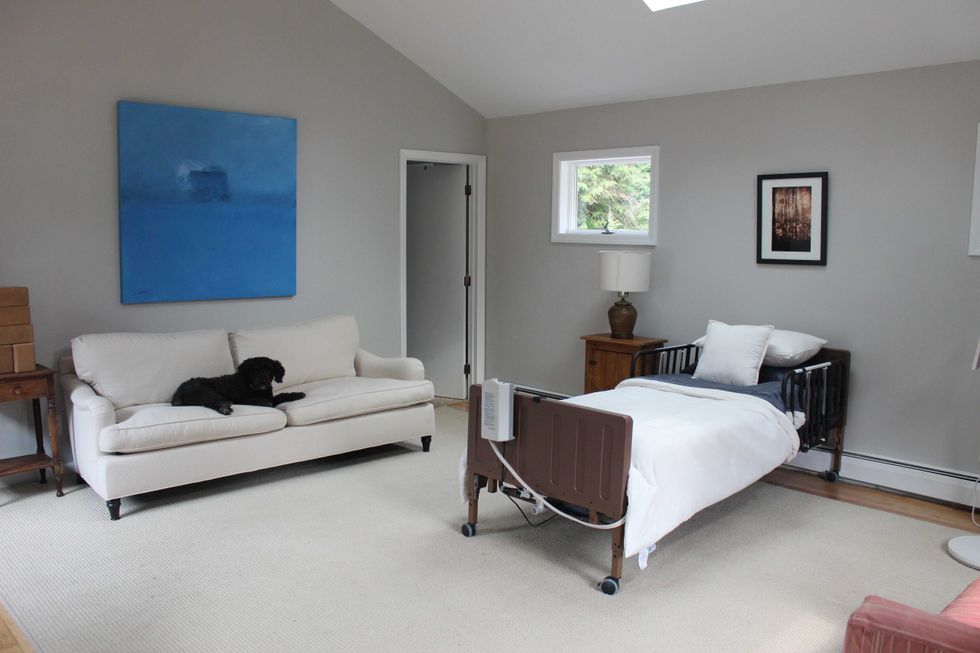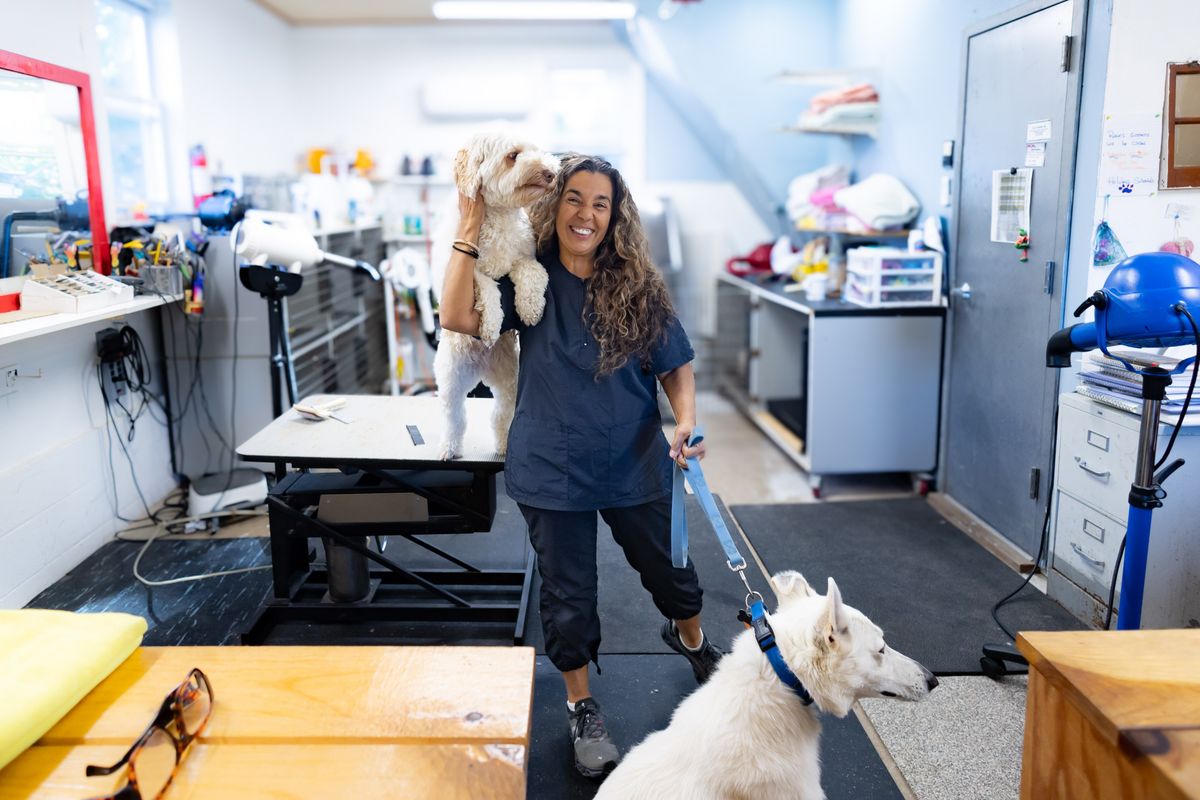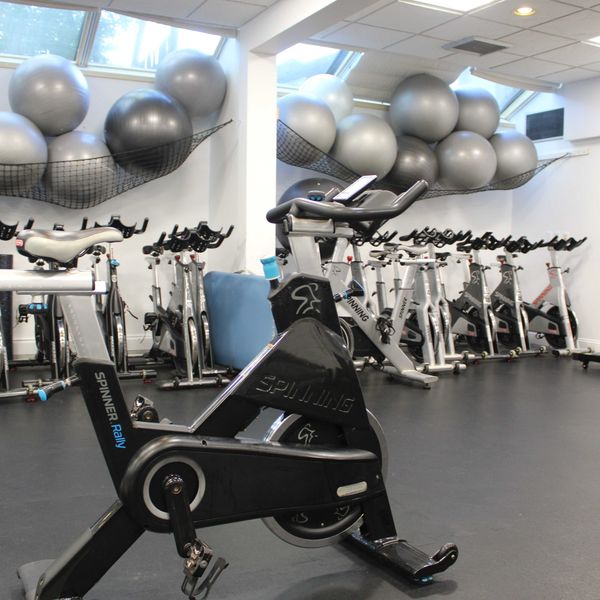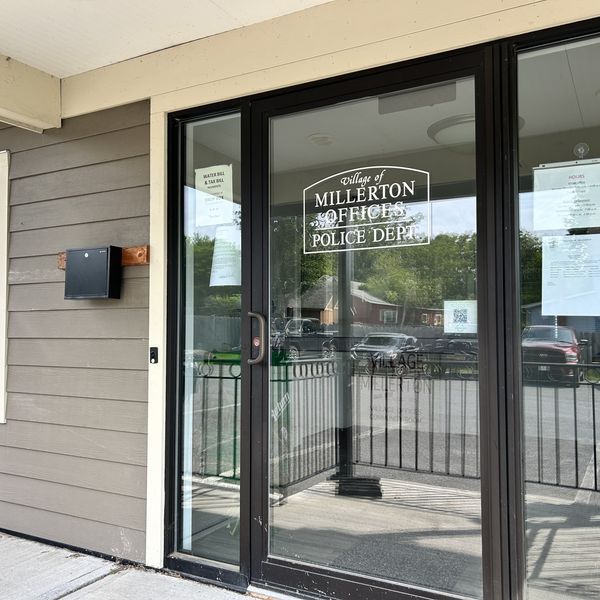Latest News
The living room is light, airy, and quiet, with works from local artists on the walls...and no television.
Patrick L. Sullivan
Craig Davis and Keavy Bedell have opened East Mountain House in Lakeville. It is an end-of-life facility — a home, really — that can accomodate up to two guests at a time. The first guest arrived in mid-September.
The house, at 14 Bostwick St., is the one Davis shared with his wife Sandy Dennis, who died in 2020. Davis said her spirit lives on in the house itself and in the approach taken for the guests.
When a visitor enters the house from the back, the first thing to do is greet Lucy the dog.
Next is to change into a pair of slippers, supplied by management.
Then the visitor is led around, with a stop in one of the guest bedrooms, complete with hospital bed and television.
The living and dining area is spacious and comfortable.
And quiet. No TV in here, quite deliberately.
In fact, there are no televisions anywhere except in the two guest rooms.
Davis said the house had to be remodeled to some extent, including removing a spiral staircase for something more conventional and practical. But the antique windows remain.
On the second floor are bedrooms for nursing staff and family members of guests, plus an office for Executive Director Cristin Gallup.
The third floor has a quiet space or “hangout.”
The house is decorated with works from local artists.
The yard is fenced in, and guests can bring a pet if the pet “is nice and gets along with Lucy.”
The entire atmosphere is influenced by Buddhism.
“It’s Buddhist without being Buddhist” said Davis.

Bedell, who is a certified end-of-life doula, said she and Davis talked about starting something for end-of-life care for some time.
“East Mountain House is 10 years from inception, with three years of earnest, hard work” she said.
The facility is affiliated with Visiting Nurses and Hospice of Litchfield County (VNHLC), so there is a trained staff presence around the clock.
Plus there are between 20 to 30 volunteers involved.
To qualify, a guest must be enrolled with VNHLC, have a medical diagnosis of three months or less to live, medical insights on what to expect at the end of life, have a signed MOLST form indicating Do No Resuscitate, have a designated health care proxy and financial power of attorney, and have a hospice plan for continued care in case of discharge.
There is a sliding scale for payment, and if a guest has few assets, there is no charge.
The effort relies on donations and volunteers. East Mountain Foundation Holdings is a 501c3 nonprofit organization.
East Mountain relies on donations and volunteers, both of which are cheerfully accepted.
East Mountain House is “our gift to the community,” said Davis, and added, “Ultimately the community will have to keep it going.”
860-596-4117
Keep ReadingShow less
With four urgent care centers and an emergency room, there are a number of options for immediate care in Torrington.
Emergency rooms are intended to treat severe conditions such as major trauma, chest pain, difficulty breathing, stroke, head trauma, neck or spine injury, severe bleeding, seizure lasting longer than 3 minutes, severe burn, vision loss, choking, electric shock or struck by lightning.

Charlotte Hungerford Hospital
Charlotte Hungerford Hospital, part of the Hartford HealthCare system, operates an emergency room in its main location at 540 Litchfield St. Live wait times can be checked online at charlottehungerford.org/services/emergency-room
Urgent cares often treat conditions such as colds, flu, fever, asthma, allergies, emphysema, minor skin lacerations, cuts, burns, urinary tract infections, sport or occupational injuries, sprains and strains. Many locations offer x-rays, drug screening, biometric testing and physicals.

Hartford HealthCare GoHealth
Hartford HealthCare GoHealth operates two urgent cares in Torrington: The location at 996 East Main St. is open Monday to Sunday 8 a.m. to 8 p.m. Phone: 860-866-5809; the location at 112 South Main St. is open Monday to Friday 8 a.m. to 8 p.m. and Saturday to Sunday 9 a.m. to 5 p.m. Phone: 860-387-4365


Concentra
Concentra operates an urgent care at 333 Kennedy Dr. Suite 202, which is open Monday to Friday 9 a.m. to 5 p.m. Phone: 860-482-4552

American Family Care
American Family Care (AFC) operates an urgent care at 1171 East Main St., which is open Monday to Friday 8 a.m. to 8 p.m. and Saturday to Sunday 8 a.m. to 5 p.m. Phone: 860-407-5048
In the event of an emergency, dial 9-1-1.
Keep ReadingShow less
Hudson Valley Hospice House in Hyde Park is the first freestanding hospice to serve Dutchess and Ulster Counties.
Provided
If you or someone in your care are approaching end of life, Medicare’s hospice benefit provides comprehensive, coordinated care for people with a life expectancy of six months or less, as certified by a doctor who can prescribe hospice services. The goal of hospice is to improve quality of life by providing support rather than curative treatment.
Hospice care under Medicare is delivered by a team that typically includes doctors, nurses, home health aides, social workers, chaplains, counselors and trained volunteers. Hospice nurses can manage symptoms and medications; aides assist with personal care such as bathing and dressing; and trained volunteers may offer companionship, run errands or provide respite for caregivers. Drugs related to the terminal illness, as well as equipment such as hospital beds, oxygen, wheelchairs and wound care, are covered at no cost by the program.
The hospice benefit is available in a patient’s home, a nursing facility, an assisted living community or an inpatient hospice center. Patients can continue receiving hospice as long as they remain eligible, and they may stop hospice care at any time if they choose to pursue curative treatment again.
The Hudson Valley Hospice in Poughkeepsie (phone: 845-485-2272) covers all of Dutchess County including the northeast corner. Visiting Nurse and Hospice of Litchfield County provides care in the Northwest Corner of Connecticut (Phone: 860-379-8561, Winsted office). In addition, your doctor or nursing facility may recommend private hospice services, which are also available at no cost.
Keep ReadingShow less
Elizabeth Wing, ND at Violet Hill Naturopathic Clinic in Sharon
Natalia Zukerman
“The body’s natural state is health and if it’s not healthy, we always ask: why not? We’re trying to help the body heal itself.”
— Elizabeth Wing, ND
Perhaps you’ve driven by the house on route 41 in Sharon that is undergoing a paint job transformation, blooming slowly into a deep, resonant purple. This is Violet Hill Naturopathic Clinic, run with deep care by Elizabeth Wing, Doctor of Naturopathic Medicine, who is devoted to tending to the whole person — body, mind and spirit. At Violet Hill, medicine is a conversation and a return to balance.
“Naturopathic medicine approaches the body and healing differently,” Wing explained. “The body’s natural state is health and if it’s not healthy, we always ask: why not? We’re trying to help the body heal itself.”
Originally from Rhinebeck, the purchase of her new home and business at 40 Gay Street was serendipitous. “We moved here in the height of COVID,” said Wing. “We didn’t have housing worked out, and by some miracle, we got this house.” The building, formerly a doctor’s office, seemed meant to be.
A graduate of naturopathic school in Seattle, Wing brings extensive experience to her practice. She primarily treats endocrine disorders, digestive issues, and autoimmune conditions, with a particular focus on reducing inflammation and improving overall health.
“New patient appointments are anywhere from 90 minutes to two hours,” said Wing. “We go through a full health history and there’s a lot of time for education around how certain things in the body are connected. For example, why your gut problems could be connected to your eczema, or how gut problems can also end up with some hormone dysregulation.”
The clinic offers unique services, including quarterly CT thermography imaging and constitutional hydrotherapy, which every new patient receives for free. “It helps calm the nervous system and helps with detoxification,” Wing explained. “This treatment has been shown to increase white blood cell count for several hours afterwards.”
Wing is accepting new patients and the wait time for an appointment is generally less than two weeks. “I’m personally pretty committed to trying to be as accessible as possible,” she said. “I try to be really good about responding to messages. That old kind of country doctor feel is kind of what I have in mind.”
Keep ReadingShow less
loading















